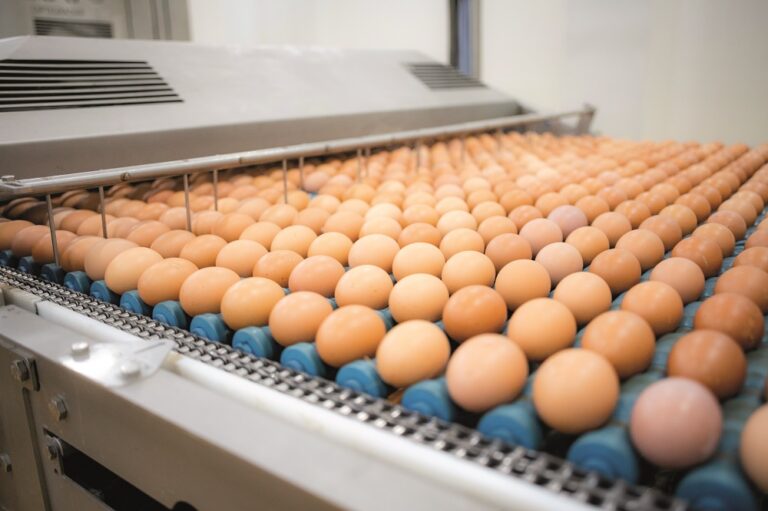By Anne Fleck, founder and managing director of Eggbase, an independent software provider to the egg industry. EggbaseProducer and EggbaseAssure software is currently used by 25% of the UK laying flock. Eggbase has just launched EggSense, its new real-time sensor and data analytics platform, and the EggbaseApp, a daily flock book app that synchronises with the existing Eggbase software.

Agri-tech is growing fast in the quest to meet the need for increased food production and deliver higher returns on investment. Whilst artificial intelligence and precision farming grab the headlines, closer to home the use of high-quality data provides opportunities to increase productivity and profitability amongst producers, packers and associated service industries.
The power of data lies in its aggregation, which allows farmers to compare their flock performance against that of a larger defined sample. Individual farmers can gain insight into their livestock’s health and welfare, optimise productivity for required egg size, and make evidence-based strategic decisions to maximise profit and ease the burden of regulatory compliance.
This ability has become accessible to the individual farmer as the cost of cloud-based Software as a Service has fallen and it is accessible from anywhere in the world with internet access, and in any language. Phone apps can provide for easy online or offline daily flock book data entry to serve sheds with no connectivity, as subsequent data upload is automatic.
The emergence of data capture platforms, that incorporate a wide range of sensors, make the collection, recording and analysis of data by an individual pullet rearer or egg producer (chicken, duck or quail) accessible and visible. Remotely sensed data flows seamlessly into software either through dedicated real-time sensors or from existing shed process controllers. These feeds provide real-time insight into temperature, humidity, carbon dioxide, ammonia levels, water and feed consumption, lux, air flow and weather. Shed-specific high & low alarm levels send warning alerts by SMS or email whilst thermal mapping and acoustics can be used to indicate the early stages of a smother, allowing poultry managers to swiftly intervene.
Individual farmers can gain access to daily graphs showing flock performance, bird weights, mortality/culls by type, environmental conditions, graded egg size distribution, egg mass, FCR, feed usage and water consumption. Grading results can be transferred seamlessly from packing stations to producers. Self -service correlation graphs are easy to configure within software showing, for example, bird weights or feed consumption vs. grading results, egg mass, type of feed or feather score. Benchmarking is a key means by which to improve performance through comparison across own flocks or across other producers in an enterprise group and provides a route to peer sharing of best practice, choice of breed, pullet supplier, feed type and management strategy.
A key feature of successful technology introduction is accurate configuration and user support. One-to-one client support is required to ensure that every subscriber has a dedicated contact who is familiar with the egg production industry to help them integrate the software into their daily routines, thereby maximising the benefits it offers.
Alongside production enhancement, data management software can lighten the administrative load of record keeping and document storage requirements for the BEIC Lion Code and other assurance schemes, thereby reducing the stress of audits.
Data confidentiality is an essential consideration and producers should check that strict data sharing permissions and commercial confidentiality agreements are in place and regularly monitored and kept up to date by the software provider. Looking into the future it is essential that the producer retains control of their individual data which will grow in commercial value as technology evolves and represents a farm product of the future. This supports and eases concerns about the sharing of aggregated data across rearer or producer groups, which gives insight into performance, graded egg size or graded egg weight by breed, rearing profile, feed type and seasonality. Permissioned data sharing between pullet rearer, egg producer and packing station allows partners to create whole-life story analysis to inform enhanced productivity cycles.
Enterprise users, including multi-site owners, egg packers, feed companies, auditors, vets, and researchers, who interact with a group of producers, can monitor production, benchmark and analyse across their specific group of pullet-rearers or egg producers to provide field support, refine performance, ensure regulatory compliance or establish bespoke management and research schedules for feed, vaccinations or bio-security. Enterprise use provides visibility of KPI’s for all rearers or producers in the enterprise and gives aggregated totals. Much like individual farmers, performance data and grading results can be benchmarked or correlated by production type, breed, rearing profile and feed type.
Automated collection, recording and analysis will never replace experience but is steadily becoming an important tool to support informed decision-making and optimisation. An important by-product is that the technology is attractive to the younger generation and thereby supports succession planning. Many in the older generation also appreciate its time-saving qualities and have embraced the opportunities now available.


